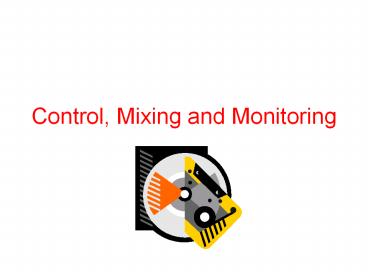Control,%20Mixing%20and%20Monitoring - PowerPoint PPT Presentation
Title:
Control,%20Mixing%20and%20Monitoring
Description:
Control, Mixing and Monitoring Operational Theory Consoles have three basic functions: amplification, routing, and mixing. Amplification (obvious). – PowerPoint PPT presentation
Number of Views:156
Avg rating:3.0/5.0
Title: Control,%20Mixing%20and%20Monitoring
1
Control, Mixing and Monitoring
2
Operational Theory
- Consoles have three basic functions
amplification, routing, and mixing. - Amplification (obvious).
- Routing sending audio to one
- destination or another, using the
- assignment switches.
- Mixing -- using volume controls (faders) to
balance and blend audio from numerous sources.
3
Types of Audio Control Consoles
- Five types of audio control
- boards/consoles
- On-air and production consoles.
- Virtual consoles exist within
- Digital audio workstations (Adobe Audition).
- Portable mixers
- Large-format mixing desks.
4
On-Air and Production Consoles
- On-air consoles in depth (see 4.3)
- http//www.ebsradio.com/_borders/millenium.jpg
- What are on-air consoles used for?
- Input selector above each channel
- allows more than one use of the channel,
- usually labeled A and B.
- Output or Assignment Buses.
- Program or Audition. May have two more auxiliary
- buses, allow for telephone feeds or talk-back.
Master output. - Listening in Cue allows material to be
previewed, - does not go on the air. Separate monitor.
- Faders and Level Control also called pots.
- Control volume level. On/off switch may be used
as - remote start.
5
Monitoring your work/On-air operational tips
- Why do we use headphones?
- When on-the-air, listen to the
- air monitor. Why?
- Dont bring drinks or food into
- the studio. Why?
- Dont rely on your ears to tell you if the signal
is loud enough or too loud. What do you use
instead? - What should be the average reading of the VU
meter?
6
Production Consoles in Depth
- Production consoles are used for creative audio
projects,recording of music, commercials, etc. - http//www.mediacollege.com/equipment/mackie/mixer
/images/onyx-1620.jpg - The In-Line Layout (see 4.6)
- Each channel strip contains input and
- output routing, monitoring, etc. controls and
- can operate somewhat independently.
- The Input Section
- The patch bay allows audio to be routed in and
out - to any location in the system (see 4.7)
7
Panoramic control and equalization
- http//www.mediacollege.com/equipment/mackie/mixer
/images/onyx-1620.jpg - Pan control allows positioning of a channel
between left and right channels - Equalization boosts or cuts certain frequencies
to emphasize the bass or treble tones - If youre not experienced, pan and equalization
can do as much to spoil a recording as they do to
improve it best to leave in center position.
8
Metering Being able to see audio
- Like pilots who learn to fly by their
instruments, audio producers must use VU meter. - Studio monitors do not, cannot and will not allow
you to judge audio levels accurately. - Audio levels are adjusted by first observing the
meters and setting the level.
9
VU meters (see 4.9)
- http//www.ledbellysound.com/images/vu-meter.jpg
- Meter has two scales The upper scale is in
volume units. - The lower scale is in percent.
- Audio above 0 VU or 100 is in danger of
distorting or clipping. - Audio below -15 VU or 20 is of no practical
value. - Audio that hits 3 VU called gone, all
distortion and clipping. - Manufacturers build headroom into boards so
that occasional peaks into the red do not cause
distortion. - VU meters show average levels, cannot always show
instantaneous peaks.
10
Peak Meter and Electronic Bar-Graph Meters
- Peak meter
- Peak meters display signal peaks, maximum signal
level (as opposed to average level on VU meter
see 4.10). Best for digital recording. Calibrated
in decibels. - LED meter
- Electronic Bar-Graph Meters use
- LED display (see 4.11). Shows sound levels
almost instantly. Shows readings from green, to
yellow and red. Can be marked in VU or peak scale.
11
Pro Speak
- Dry signal unprocessed audio
- signal.
- Wet signal processed audio
- signal, contains special effect.
- Interruptible foldback (IFB)
- allows board operator to talk to the talent.
- Hard clipping beyond distortion
- break up.
- Headroom additional capacity.































